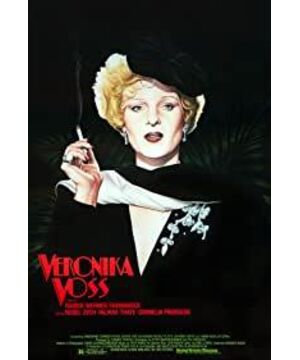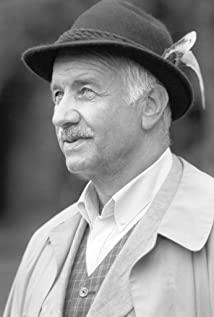Fassbender (1946-1982), the master of the "New German Cinema", died suddenly at the age of 36. He is cynical and thoughtful, always "traveling the world in a hurry", and with superhuman energy and enthusiasm, he has created more than 40 films and TV works in his short 13-year film career. The representative works of her artistic maturity are the famous German women's quartet: "Marriage of Maria Braun" (1978), "Lily Marlene" (1980), "Lola" (1981), "Veroni" Car Firth's Desires (1982). These four works, united by a unified artistic motif—historical decadence and despair—compose a stylistically self-contained image reflecting the war and postwar reality of the Nazi “Third Reich”. The integrated artistic scroll actually constitutes an artistic expression of Germany's recent and modern history. It can even be said that no matter who the heroine is in the film, it is deeply engraved with Fassbender's unique spiritual imprint and A bitter meditation on history. It can be said that this four-part series is not only a well-ordered long-volume epic, but also can be read as Fassbender's self-portrait (the wandering of spirit and flesh in history).
Fassbender dedicated it to the former Ufa movie star Hibile Schmitz who died of drug addiction in 1955. . In doing so, Fassbender is definitely not just providing people with a sensational story of the fall of the silver star, but focuses on revealing the heroine (although based on Schmitz, but far beyond the individual existence. Schmitz)'s split personality and its inner melody, and associate the fall of this silver star with the political, economic and intriguing interpersonal relationships of post-war Germany (especially the "Third Reich" that permeated these relationships. "The Spiritual Spectre) are closely juxtaposed and blended together, drawing a picture of a deformed social mentality filled with the breath of death.
The heroine Foss successfully played the drug addict on the screen in the past, and her real situation and perverted psychology formed a peculiar "layered" and contrasting relationship. In the past: Foss's artistic creations marked the golden years of her life; now: she is already old and young, addicted to drugs due to inescapable spiritual emptiness, and is tragically slipping into the dark abyss of death step by step. The "other and me" (character) created in the past was controlled by the witch doctor because of drug use. She had such a prophetic monologue: (to the female doctor) "Now everything I have belongs to you, Now my whole life belongs to you, and now I can only dedicate my death to you." The "self" who lives now is controlled by the woman because of drug addiction (drug addiction has become a spiritual sustenance without sustenance). Doctor Katz is repeating the tragic mistakes of "he and me" step by step. In particular, Katz implemented a fascist dictatorship under the guise of practicing medicine, and in a certain way of trading - Katz injected Foss with morphine, and Foss mortgaged all his property to Katz in the form of a will, and continued to squeeze The money and lives of the Foss (including the old couple who committed suicide in desperation because their property was completely mortgaged). This relationship between the patient and the doctor (drug use and drug control, desire and desire fulfillment) has become a modern version of Dr. Caligari's relationship with patient Chezar. What shocks people even more is that the Katz, who represent power, despotism, and violence (that is, the spirit ghosts of the "Third Reich" who will not die), won overwhelmingly, even in their evil deeds. People can't find blood in it; and the "desire" of the Foss (actually a symbol of human life desire) is artistically magnified and presented as a sincere call of "human nature, come back". In this real world full of power and evil, the specter of fascism is still wandering and wandering. The intrusion of reporter Robert and the various actions to expose the evil and save Foss are like soap bubbles with dazzling colors. , shattered in an instant—his girlfriend Helite lost his life, and Foss was helpless (even refusing to testify to expose his guilt) in desperation toward death (both homicide and suicide), that The call of "Humanity, come back" was originally as weak as a gossamer, and the moment was mercilessly swallowed up by this sinful world.
In Fassbender's quartet of German women composed with painstaking efforts, this "extraordinary work" is different from the previous three films shot in color films. Fassbender deliberately used black and white film tones to construct the work. artistically shaped. When a reporter asked him, "Why did you make this film in black and white?" he replied, "I can't imagine it any other way. Also black and white is not always black and white. Our film is of course what people can imagine. This black-and-white film is black and white in every way." Black and white, here not only exists as a tone or style factor, but also is endowed with a symbolism and becomes an ideographical The method not only shows (with low-key images) Foss's psychopathic and last struggle to find himself in the midst of despair and despair; at the same time, it also highlights (with high-key images) Katz, who is the embodiment of the historical spirit of the "Third Reich", in his work. The tyranny and ugliness of the white and dazzling psychiatric clinics are masked by humanity and solemnity. Here, the image as the "signifier" and the historical background of the same narration as the "signified" are precisely reflected as a kind of meaningful historical discourse formed by the two "oppositely complement each other" in the collision and competition. It is a fairly typical "post-modern" art form.
As the famous German scholar Michael Kohler pointed out: "Postmodernism is not just a specific style, but a series of attempts to transcend modernism. The 'rebirth' of a disregarded artistic style." Perhaps one of the most controversial issues of "postmodernity" centers on this: a certain "non-selectivity" of narrative and the linguistic devices it uses, as Postmodern writing principles can be further embodied as: (1) no depth; (2) narrative fragmentation; (3) escapism from the subjectivity of art—do these all mark the dismemberment of narrative, or the reconstruction of narrative? Obviously, in this theoretical focus, postmodern artists are looking for "difference", not "consensus". The "non-selective" chosen by Fassbender is a well-thought-out reconstruction of the film narrative in a postmodern sense, and even includes various references to the classic film narrative, that is, "various The 'rebirth' of an artistic style rejected by modernism."
One end of the "quote": The narrative framework of "The Desire of Veronica Foss" seems to be a "detective film". Here, there are various elements of a detective film, such as the familiar conflict pattern that opens at the point of crisis - the special "deal", confrontation and entanglement between the patient Foss and the doctor Katz, while the reporter Robert plays a Like a private detective. From beginning to end, the film closely follows the action line of this life-and-death struggle, and everywhere pervades an atmosphere of murder and being murdered, desire and conditioned and stifled desire (the surface form is: the desire to be satisfied) . Foss uses drugs to anesthetize herself and escape history, but at the same time she indulges in "history" (the golden years of the "black hair" period). In addition to this self-enclosed "narcissism complex" (nostalgia), Foss no longer has any current plans or future visions. Katz, on the other hand, is "fighting poison with poison" to implement the absolute tyranny of the Foss. His appearance is sympathetic but his heart is as cold as marble, as if it is the "rebirth" of Dr. Caligari. However, Robert, who was given the identity of a private detective, suddenly broke into Katz's "forbidden land" and went through all dangers, but failed miserably. After Foss' funeral, Robert took off his black veil, threw it angrily on Katz's car, and left the stage in disappointment. And Katz is now staggering with the city's medical and health officials to celebrate the victory. History is history, and history is so irrevocably decadent. The only thing Fassbender has to offer the audience is despair and contemplation of despair.
How could Fassbender be able to borrow (quote) the narrative form of the "detective film" so easily, yet launch an epic work with a rich historical background? Here, let’s listen to Fassbender’s answer to a reporter’s question shortly before his death: “I want to write a book to describe the peculiar history of the emergence and development of the Federal Republic of Germany. I want to trace the source: why is the Federal Republic of Germany what it is today? It is this kind of profound "historical complex" that enables him to play a deep role in the collision and competition between the "signifier" of detective films and the "signified" of historical roots. Dive into the depths of history and human mental aberrations (Foss is a mentally ill person), linking the "economic miracle" of post-war Germany and the spiritual crisis (despair and suicide) of people concealed by this economic miracle, Linking the material prosperity and spiritual poverty after the war with the ghost of the "Third Reich" history that is still alive, and pushing all this to the judgment seat of history. In this way, Fassbender uses no depth, narrative fragmentation, escaping from artistic subjectivity, etc. as narrative strategies, invisibly citing the "detective film" form while giving it a thorough transformation to achieve narrative. reconstruction and regeneration.
Fassbender's important contribution to world cinema is focused on one point: elevating cinematic narrative to a form of historical discourse composed of a rivalry between signifiers and signifieds (not the apparent convergence of the inside and the outside at a glance) Form, over the heads of modern film masters such as Bergman, Godard, Fellini, etc., confidently and generously entered the field of postmodern art.
The silver star has fallen, and history has fallen. Shouldn't people be alert and rational enough to speculate from history? ! Fassbender's artistic development in the postmodern field can be read as an improvement of a "historical complex".
View more about Veronika Voss reviews











